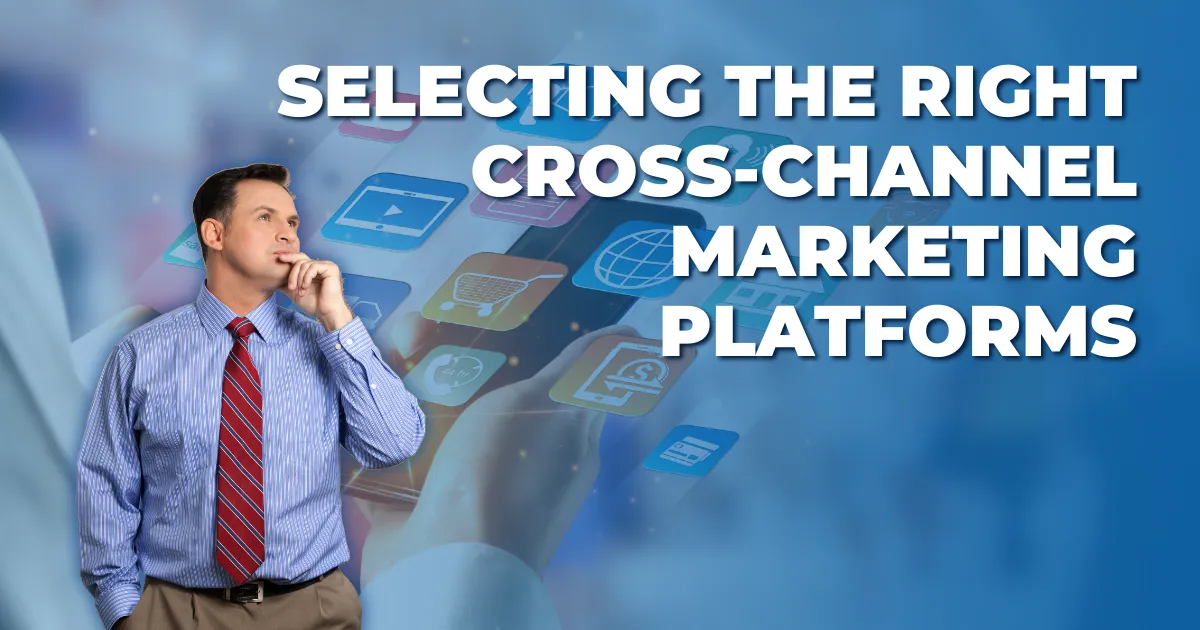Generating targeted leads is the cornerstone of any successful marketing strategy, and it’s more crucial than ever in today’s competitive landscape. Focusing on precision in your lead generation efforts increases conversions and builds stronger, more meaningful relationships with your prospects.
By honing in on your target audience’s specific needs and pain points, you can craft personalized messages that resonate deeply, driving engagement and trust. This article will explore the precision power and how you can effectively generate targeted leads that meet and exceed your business goals.
Understanding Cross-Channel Marketing
In the ever-evolving digital marketing world, the ability to generate targeted leads has become a critical factor in achieving business success. Unlike broad, generalized approaches, targeted leads allow businesses to focus their marketing efforts on audiences most likely to convert into loyal customers. This precision maximizes return on investment (ROI) and fosters deeper connections with potential clients.
What is Cross Channel Marketing?
Cross-channel marketing is using multiple marketing channels in a coordinated and cohesive manner to reach your audience. Unlike traditional single-channel marketing, which focuses on one platform at a time, cross-channel marketing ensures that your messaging, branding, and customer experience remain consistent across various platforms—social media, email, websites, or offline channels. This unified approach helps build stronger relationships with your audience.
The Evolution of Cross-Channel Marketing
Marketing strategies have come a long way from focusing on individual channels. Previously, businesses concentrated their efforts on a single medium, such as print ads or email marketing. However, as consumer behavior has shifted and technology has advanced, so have marketing strategies.
Today, consumers expect to engage with brands across multiple touchpoints, from browsing your website on their laptops to following your social media updates on their smartphones. Cross-channel marketing evolved as a response to these changes, allowing businesses to meet their customers wherever they are in a natural and connected manner.
Benefits of a Cross-Channel Marketing Strategy
Implementing a cross-channel marketing strategy offers numerous benefits that can significantly enhance your brand’s performance:
- Enhanced Brand Visibility: Being present on multiple channels increases the chances of your audience encountering your brand, boosting visibility and awareness.
- Improved Customer Engagement: Cross-channel marketing allows you to engage with your audience in various ways, tailoring your approach to each platform’s characteristics. This leads to more meaningful interactions and a deeper connection with your brand.
- Higher ROI: A well-executed cross-channel marketing strategy ensures that your resources are used efficiently. By delivering a consistent message across platforms, you can reinforce your brand’s value proposition, leading to higher conversion rates and return on investment.
- Seamless Customer Experience: One of the critical advantages of cross-channel marketing is its ability to provide a seamless customer journey. Customers who receive a consistent experience across all touchpoints are more likely to develop trust in your brand and continue engaging with it over time.
Designing Effective Cross-Channel Marketing Campaigns
Creating successful cross-channel marketing campaigns requires more than just spreading your message. It involves strategic planning, consistent messaging, and data-driven optimization to ensure each channel complements the others, delivering a unified and impactful brand experience. Here’s how to design cross-channel marketing campaigns that resonate with your audience and drive results.
Setting Clear Objectives for Your Campaigns
The foundation of any effective cross-channel marketing campaign is a clear set of objectives. What are you hoping to achieve? Whether boosting brand awareness, generating leads, or driving conversions, your standards should be specific, measurable, achievable, relevant, and time-bound (SMART). Here’s how to set clear objectives:
- Increase Brand Awareness: Focus on boosting social media engagement, growing your email list, or increasing website traffic.
- Generate Leads: Develop strategies to capture potential customers through forms, lead magnets, or targeted offers.
- Drive Conversions: Optimize your campaigns to convert leads into customers by using compelling calls to action and personalized messaging.
- Enhance Customer Loyalty: Implement loyalty programs or personalized follow-ups to retain and engage your existing customers.
Crafting Consistent Messaging Across Channels
Consistency is key in cross-channel marketing. Your audience should receive the same message, tone, and brand experience no matter where they interact with you. Here’s how to craft consistent messaging:
- Adapt Content for Each Platform: Tailor your core message to fit each channel’s unique characteristics, such as professional tones for LinkedIn and visual storytelling for Instagram.
- Maintain a Cohesive Narrative: Ensure that all content, whether on social media, email, or your website, aligns with your brand and reinforces your key messages.
- Use Visual Consistency: Employ consistent branding elements like logos, colors, and fonts across all platforms to strengthen brand recognition.
- Align with Campaign Goals: Ensure that the messaging supports your campaign objectives, whether to inform, persuade, or engage your audience.
Leveraging Data to Optimize Campaigns
Data is the backbone of any effective cross-channel marketing campaign. By analyzing performance metrics, you can gain insights into what’s working and what’s not. Here’s how to leverage data:
- Monitor Key Metrics: Track click-through rates, conversion rates, engagement levels, and customer feedback to gauge the effectiveness of your campaigns.
- Utilize Analytics Tools: Use platforms like Google Analytics, social media insights, and marketing software to gather and analyze data from each channel.
- Adjust Strategies in Real-Time: If specific channels outperform others, reallocate resources or tweak your approach to maximize effectiveness.
- Test and Refine: Continuously A/B test various campaign elements, such as headlines, images, and CTAs, to learn what resonates most with your audience.
- Integrate Feedback: Use customer feedback and interaction data to refine your messaging and approach, ensuring your campaigns are customer-focused and relevant.
This structured approach ensures that your cross-channel marketing campaigns are well-planned, consistent, and data-driven, leading to better engagement and results across all platforms.
Selecting the Right Cross-Channel Marketing Platforms
Choosing the right platforms for your cross-channel marketing strategy is decisive to reaching your target audience effectively and maximizing your campaign’s impact. With so many platforms available, from social media networks to email and search engines, selecting those that align with your brand’s goals and audience preferences is essential. Here’s how to make informed decisions when selecting cross-channel marketing platforms.
Identifying the Best Platforms for Your Audience
The first step in selecting the right platforms is understanding where your audience spends their time. Not all platforms are equally effective for every brand, so focusing on those that offer the best chances to connect with your target market is essential. Consider the following:
- Audience Demographics: Research the demographics to ensure they match your target audience. For example, platforms like Instagram or TikTok may be more effective if your audience skews younger.
- User Behavior: Understand how users engage with content on each platform. For instance, LinkedIn is ideal for B2B marketing, while Pinterest is better suited for visually-driven consumer brands.
- Platform Popularity: Evaluate each platform’s popularity and growth trends. A platform that is growing in popularity could offer new opportunities for reaching a wider audience.
Integrating Social Media with Other Channels
Social media platforms are pivotal to cross-channel marketing, but their effectiveness is amplified when integrated with other channels like email marketing, paid advertising, and content marketing. Here’s how to seamlessly connect social media with other channels:
- Cross-Promote Content: Share your blog posts, videos, and other content across social media to drive traffic to your website or landing pages. This not only boosts content visibility but also enhances engagement across channels.
- Coordinate Campaigns: Align your social media efforts with email marketing campaigns or paid ads to reinforce your messaging. For example, targeted social media ads can support a special offer promoted via email.
- Use Retargeting: Implement retargeting ads on social media platforms to reach users who have previously engaged with your website or email content, helping keep your brand in mind.
- Leverage User-Generated Content: Encourage your audience to develop and share content about your brand, and then integrate this content into your other marketing channels to build trust and authenticity.
Tools and Technologies for Managing Cross-Channel Marketing
Effective cross-channel marketing requires the right tools to manage and optimize your efforts across multiple platforms. Here’s a look at some essential tools and technologies:
- Marketing Automation Platforms: Use tools like HubSpot, Marketo, or Pardot to automate email marketing, social media posting, and lead nurturing, ensuring consistent communication across channels.
- Analytics Tools: Google Analytics, Hootsuite Insights, and other analytics platforms help you track performance across all channels, providing insights that can guide your strategy.
- Content Management Systems (CMS): A robust CMS like WordPress or Drupal can streamline content creation and distribution, making it easier to maintain consistency across platforms.
- Customer Relationship Management (CRM) Software: Integrating a CRM system like Salesforce or Zoho with your marketing platforms allows you to manage customer interactions and data across all touchpoints, ensuring a unified approach to customer engagement.
By carefully selecting the right cross-channel marketing platforms, integrating them effectively, and utilizing the right tools, you can create a cohesive and powerful marketing strategy that echoes with your audience and drives results across multiple channels.
Conclusion
Mastering a cross-channel marketing strategy is no longer a luxury; it’s necessary in today’s interconnected digital world. Understanding the essence of cross-channel marketing, designing campaigns that resonate across platforms, and selecting the right tools and channels can elevate your brand. Each step of this journey is an opportunity to strengthen your relationship with your audience, turning every interaction into a meaningful connection. With the right approach, your cross-channel efforts will enhance brand visibility and drive unparalleled results.
Ready to take your marketing strategy to the next level? Let’s start building a unified, cross-channel approach that delivers actual results! Contact us today at 1 800-397-2599 or visit our contact page to get started. Your next big marketing breakthrough is just a call away!







